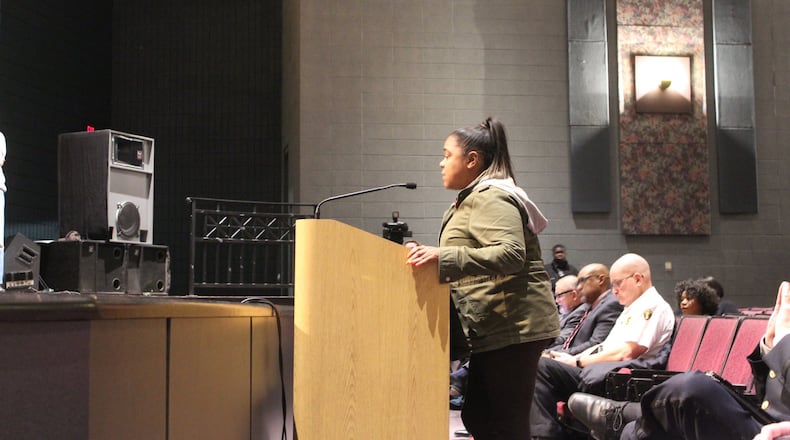During Wednesday’s city commission meeting, about eight people asked the city not to discontinue the program, claiming it is still needed to combat blight and help low-income homebuyers. Some said citizens should have received more advance warning about its termination.
“I have heard from many residents that it is unfair for the program to stop so abruptly, without them having an opportunity to adjust or be able to take advantage of the program,” said Kenya Baker, a Dayton resident and self-described community organizer.
MORE: Dayton, treasurer plan to end Lot Links program due to economy upswing
But city and county officials say the local real estate market has strengthened to the point where the program no longer makes sense, especially considering that it deprives schools, parks, libraries and other public agencies of delinquent taxes they are owed.
Launched in 2008, Lot Links was a partnership between the city and the Montgomery County Treasurer’s office that allowed citizens to apply for vacant and tax-delinquent properties. Originally, the program was only for vacant lots, but later was expanded to include properties with structures.
After receiving an application, the city initiated an administrative tax foreclosure process and after a wait of about two years, applicants could acquire the properties, with the back taxes removed, often for less than $2,500.
Lot Links was successful, but it evolved far beyond its original intent to help properties owners get side yards and empty lots into a way people acquired homes for cheap, with back taxes wiped clean that if collected would help fund critical public services, city and county officials said.
MORE: Dayton program for rehabbing homes facing a major backlog
On Wednesday, Baker and a handful of other citizens took the podium at the city commission meeting to ask city leaders and officials to extend Lot Links.
Baker said Lot Links has helped reduce blight in the city’s neighborhoods. She said the city should keep the program going at very least for one more year.
The loss of Lot Links eliminates affordable housing access and opportunities and gives out-of-town investors the upper hand in acquiring tax delinquent properties, said Shenise Turner-Sloss, a resident and former city commission candidate.
“The people of Dayton want to know what effort was made to improve the existing Lot Links program,” Turner-Sloss said. “How many public forums and public hearings were convened before the decision was made to dismantle Lot Links?”
The city should not have ended the program so suddenly and during the holiday season when people are extremely busy, said Dee Wooding, a Dayton resident involved with the Westwood Right Project.
The city and Montgomery County treasurer officially announced the program was ending at the Dec. 11 city commission meeting, and the program was shut down the next week.
MORE: 1,000 and counting: Dayton’s home fixer-upper program grows
That did not give people nearly enough time to identify properties they might want to pursue and prepare and submit an application, Wooding said.
The program is a valuable tool to help low-income citizens become homeowners, and it has helped return many vacant and tax delinquent properties to productive use, she said.
“If it’s successful, why would you stop the program,” she said.
In response to speakers' comments, Dayton City Manager Shelley Dickstein said while Lot Links is ending, the county treasurer still offers the Depositor Foreclosure Program, which allows people to buy tax-delinquent properties in the city.
Dickstein said dozens of people already use the program, which takes less time for applicants to acquire properties, sometimes at lower costs than what they would have paid through Lot Links.
“We didn’t take away a tool,” she said. “The program still exists.”
That program is better suited to the times and market that also achieves the same goal of transitioning vacant properties from delinquent owners to new, more responsible tax-paying ownership, Montgomery County Treasurer Russ Joseph said. “Oftentimes, it’s a quicker process than Lot Links,” Joseph said. “And, depending on the type of property, it can be less expensive for people, too.”
MORE: Dayton’s Lot Links: How program went from sideyards to money-maker
One big difference between Lot Links and the depositor foreclosure program is that people who use the depositor program are not guaranteed the properties they apply for and the back taxes are not automatically eliminated.
Applicants must submit a deposit, but their payments are returned if they are unsuccessful in buying the property.
After receiving an application, the treasurer’s office starts a tax foreclosure, and once a default judgment is signed by a judge, an order of sale is issued by the Montgomery County Sheriff’s Office.
The property is then offered at public auction (sheriff’s sale) for a minimum bid of court costs and the amount of back taxes owed, Joseph said. If there are no bidders at the two sales, a third and fourth sale will be held, and the property will be offered at the minimum bid of the court costs.
The sheriff’s sale makes it a more open, transparent and fair process that also provides an opportunity to collect delinquent taxes, which is the treasurer’s main responsibility, Joseph said.
Increasingly and overwhelmingly, Lot Links applicants were seeking properties containing structures, which was not the original intent of the program but is a good sign that people want to live and invest in Dayton, Joseph said.
The city estimates that 90 percent of Lot Links applications in the last three years were for properties containing structures.
Vacant lots and yards seldom owed significant back taxes, but structures are a different story, Joseph said.
The program was writing off large amounts of delinquent taxes that the schools, libraries, parks, human services and government agencies are owed and need to provide critical services, Joseph said.
Dayton Mayor Nan Whaley said Lot Links was a good way to deal with properties no one wanted, but it was no longer effective because it had an extremely slow process, was misused and there are better tools available.
About the Author

